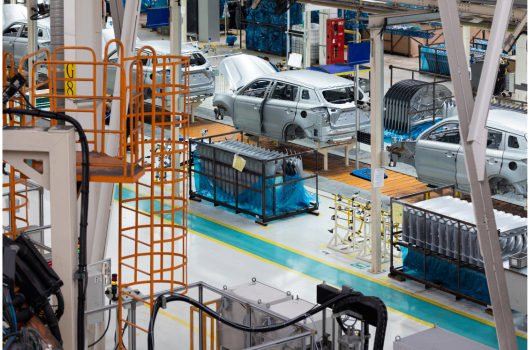Industry fell in November
Economic commentary by Jakub Seidler, Chief Economist of the CBA

Industrial production disappointed in November, falling by 2.7 % year-on-year, while the market had expected a more modest fall of 1.5 % (see Chart 1). It fell by 1.4 % month-on-month. While in October the industry was driven by some one-off effects and grew by a better-than-expected 1.9 % yoy, in November these factors have already faded and some have been added which, on the contrary, visually worsen the result - in particular, car production no longer grew at a double-digit pace due to the acceleration in production and the low comparative base and added only 2 % in November, failing to offset a number of declining industries. The domestic industry thus remains in recession and will end up in a slight decline of around half a percent for the full year 2023. For the time being, neither the PMI indicators nor the still subdued industrial orders in Germany, which indicate weaker demand in the euro area, are bringing optimistic prospects. So far this year, the analysts' consensus expects industrial growth of 1.7 %.
In October, the industry was driven by several one-off influences, the completion of a large rail order, the unwinding of the decline in gas/thermal power generation, which had already fallen back into the red in November (Chart 2), and in particular strong car production - both due to the low 2022 benchmark and making up for the September fallout. In November, some of the one-off effects faded and, in contrast, a high comparative base was at work for autos, with November 2022 among the strongest months of the year after the shortfalls. On a month-on-month basis, automobile production thus fell by 4.5 % (it had risen by 11 % in October), and year-on-year growth was "only" 2 %, compared with over 20 % in October (Chart 3). Thus, the positive contribution of autos to the half-percent year-on-year growth, together with more favourable electrical equipment production, failed to offset continued declines in the production of a number of other industries. Machinery and construction materials manufacturing saw the most significant declines in terms of contributions in November.
New orders moderated their year-on-year decline, mainly due to more favourable orders for automobiles, electrical equipment and longer-term orders for rolling stock, but overall they were flat year-on-year in November, while the figure is in current prices unadjusted for inflation (Chart 4).
After a surprising October, November's industry figures thus confirmed the one-off nature of the previous month's favourable figures. By contrast, although November's numbers are also slightly worse optically, domestic industry remains in recession and the outlook remains less optimistic. This was confirmed by German industrial orders, which, although up marginally by 0.3 % in November after a sharp fall in October, fell short of market expectations (1 %) and also suggest that demand is falling, especially from the euro area countries (-1.9 % mom).
November's industrial production was thus exactly at the average level of 2019, showing that industrial production has not improved much over the last 4 years, with car production being an exception in this respect, as it was 18 % above the average of 2019 in November (Chart 5). For the whole of this year, the analyst consensus according to Focus Economics expects domestic industry to grow by 1.7 %, while it is likely to decline by half a percent in 2023.
In October, the industry was driven by several one-off influences, the completion of a large rail order, the unwinding of the decline in gas/thermal power generation, which had already fallen back into the red in November (Chart 2), and in particular strong car production - both due to the low 2022 benchmark and making up for the September fallout. In November, some of the one-off effects faded and, in contrast, a high comparative base was at work for autos, with November 2022 among the strongest months of the year after the shortfalls. On a month-on-month basis, automobile production thus fell by 4.5 % (it had risen by 11 % in October), and year-on-year growth was "only" 2 %, compared with over 20 % in October (Chart 3). Thus, the positive contribution of autos to the half-percent year-on-year growth, together with more favourable electrical equipment production, failed to offset continued declines in the production of a number of other industries. Machinery and construction materials manufacturing saw the most significant declines in terms of contributions in November.
New orders moderated their year-on-year decline, mainly due to more favourable orders for automobiles, electrical equipment and longer-term orders for rolling stock, but overall they were flat year-on-year in November, while the figure is in current prices unadjusted for inflation (Chart 4).
After a surprising October, November's industry figures thus confirmed the one-off nature of the previous month's favourable figures. By contrast, although November's numbers are also slightly worse optically, domestic industry remains in recession and the outlook remains less optimistic. This was confirmed by German industrial orders, which, although up marginally by 0.3 % in November after a sharp fall in October, fell short of market expectations (1 %) and also suggest that demand is falling, especially from the euro area countries (-1.9 % mom).
November's industrial production was thus exactly at the average level of 2019, showing that industrial production has not improved much over the last 4 years, with car production being an exception in this respect, as it was 18 % above the average of 2019 in November (Chart 5). For the whole of this year, the analyst consensus according to Focus Economics expects domestic industry to grow by 1.7 %, while it is likely to decline by half a percent in 2023.
Disclaimer: Text translated automatically, excuse any imperfections.